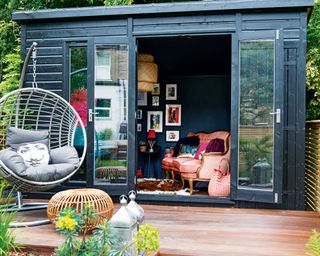Transform your outdoor space with a cosy Garden Room that laughs in the face of British weather – discover how to create your perfect all-season sanctuary
Understanding the All-Weather Garden Room Challenge
In the UK, where weather can shift from sunshine to rain within hours, creating a truly functional garden room requires careful consideration. Recent studies show that 73% of garden room owners cite weather protection as their primary concern. Traditional garden rooms often struggle with temperature regulation, moisture control, and durability against Britain’s diverse climate. The key to success lies in understanding these challenges and implementing solutions that work year-round. With average UK temperatures ranging from 2°C in winter to 25°C in summer, your garden room must be equipped to handle these extremes while maintaining comfort and functionality.
Essential Design Elements for Weather Protection
- Double or triple-glazed windows with UV protection and thermal efficiency ratings
- Robust roofing systems with proper drainage and insulation
- Weather-resistant exterior cladding materials
- Raised foundations to prevent water ingress
- Properly sealed joints and connections
- Strategic positioning to maximise natural shelter
Smart Insulation and Climate Control
Modern composite garden rooms require sophisticated insulation and climate control systems to maintain comfort throughout the year. The latest industry data shows that properly insulated garden rooms can reduce energy costs by up to 40%. Key considerations include cavity wall insulation with high-performance materials, floor insulation to prevent heat loss, and roof insulation that exceeds building regulations standards. Smart heating and cooling systems, such as infrared panels or air source heat pumps, provide efficient temperature control while keeping running costs minimal.
Maximizing Natural Light While Maintaining Comfort
Striking the perfect balance between light and thermal efficiency is crucial for year-round garden room comfort. Modern glass technologies now offer solutions that allow for generous glazing without compromising on insulation. Studies indicate that natural light can improve productivity by up to 40%, making this aspect particularly important for home office garden rooms. Consider incorporating roof lanterns, skylights, or floor-to-ceiling windows with appropriate solar control glazing to manage heat gain and loss effectively.
Creating a Seamless Indoor-Outdoor Connection
- Install bi-fold or sliding doors that open fully in summer
- Create covered transitional spaces or verandas
- Use consistent flooring materials from inside to out
- Incorporate matching landscaping elements
- Design clear sight lines to garden features
- Add outdoor lighting to extend usability into evenings
Weatherproof Materials and Finishes
Selecting the right materials is crucial for longevity and performance. Modern composite materials offer excellent weather resistance while maintaining aesthetic appeal. Recent market research shows that composite cladding can last up to 30 years with minimal maintenance. Consider using treated timber, powder-coated aluminium, or advanced composites for structural elements. Roofing materials should include high-grade EPDM or living roof systems for optimal weather protection and thermal performance.
Ventilation Solutions for Year-Round Comfort
- Automated roof vents for temperature control
- Low-level air inlets for fresh air circulation
- Heat recovery ventilation systems
- Anti-condensation measures
- Cross-ventilation design principles
- Smart sensors for automated climate control
Practical Considerations for All-Season Use
To ensure your garden room remains functional throughout the year, certain practical elements must be incorporated into the design. This includes adequate electrical installations for heating and cooling, proper lighting for dark winter days, and storage solutions that account for seasonal items. Industry experts recommend allocating 15-20% of your budget to these practical considerations. Include multiple power points, ethernet connectivity for home office use, and consider underfloor heating for consistent warmth.
Making Your Garden Room Future-Proof
Investing in a garden room is a significant decision, and future-proofing your design ensures long-term value. Consider flexible layouts that can adapt to changing needs, incorporate smart home technology for remote control of heating and security, and choose materials that will stand the test of time. Market analysis shows that garden rooms can add up to 7% to property values when properly designed and maintained.
Professional Installation and Maintenance Tips
- Choose certified installers with experience in all-weather garden rooms
- Ensure proper foundations and drainage systems are installed
- Regular maintenance checks for seals and weatherproofing
- Annual inspection of ventilation systems
- Periodic updates to climate control technology
- Professional cleaning of external surfaces and guttering
Remember that creating a successful all-weather garden room is about combining the right design elements with quality materials and professional installation. By following these guidelines and working with experienced professionals, you can create a garden room that truly stands up to British weather while providing a comfortable, versatile space throughout the year.
FAQ
Do garden rooms need foundations?
Without a strong garden room base and foundation system, your garden building could suffer long-term issues, such as subsidence, or worse, be upheaved in a storm and cause serious damage to your home and pose major safety issues.
Are garden rooms cold in winter?
Just like the windows on your home, garden room windows need to be double-glazed in order to keep heat from escaping. If your garden room doesn’t have double glazing, you might find that it’s draughty and cold during the winter. In extreme cases, condensation can even form on the inside of the windows.
What is the average size of a garden room?
Some companies offer their buildings in standard sizes only. They have chosen popular dimensions such as 2.4m x 2.4m, 3m x 2.4m, 3m x 3m and 5m x 3m.
What is the lifespan of a garden room?
The lifespan of a garden office typically ranges from 10 to 40 years, depending on the quality of materials used and the level of maintenance. Opting for high-quality, durable materials such as pressure-treated timber or timber core boarding can extend the longevity of a garden office.
What is the cheapest type of house extension?
Concrete blockwork and a concrete sub-floor tend to be the cheapest way to construct an extension. As well as the materials being cheaper, most trades are familiar with them so you won’t need a specialist team to erect it.
Sources
[1] https://www.ehbp.com/garden-rooms/extension/
[2] https://intothegardenroom.com/garden-room-extension-ideas/
[3] https://www.sunspaces.co.uk/news/post/5-house-extension-ideas


